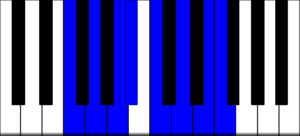You can approach the creation of a jazz piano lick over a 7-3-6 or minor 2-5-1 chord progression just as you would for a 2-5-1 lick in a major key. You can use
-
- chord tones
- arpeggios
- triplets
- a line that moves up and down
- approaches to chord tones.
Here is an example for a lick using these elements that you can use whenever you come across a minor 2-5-1.

-
- The first bar consists of notes that are just moving up and down the F major (or D minor) scale, starting on the flatted fifth of the Em7b5 chord, Bb.

The F major scale

-
- The last Ab is an approach to the following A, which is the beginning of an arpeggiated A minor 7 chord. The line then moves down again diatonically. The bar ends with another approach.
- This time it moves to the root D of the following Dm7 chord. What follows is a small rhythmical motive with two eighth notes followed by one quarter note, moving down the diatonic scale again. The lick ends on D.
As you can see, with a few simple elements you can create a nice lick just using the diatonic scale and chord tones. Play around with these concepts to come up with your own licks!
Once you understand how to solo over major 2-5-1s as well as the above 7-3-6 (or minor 2-5-1) chord progression, you are in a good position to solo over entire jazz tunes. The concepts won’t change for the rest of the chords of the tune. So get creative with your playing and practice one concept at a time, starting with just a few chords. Expand gradually to longer solo lines and chord progressions.

